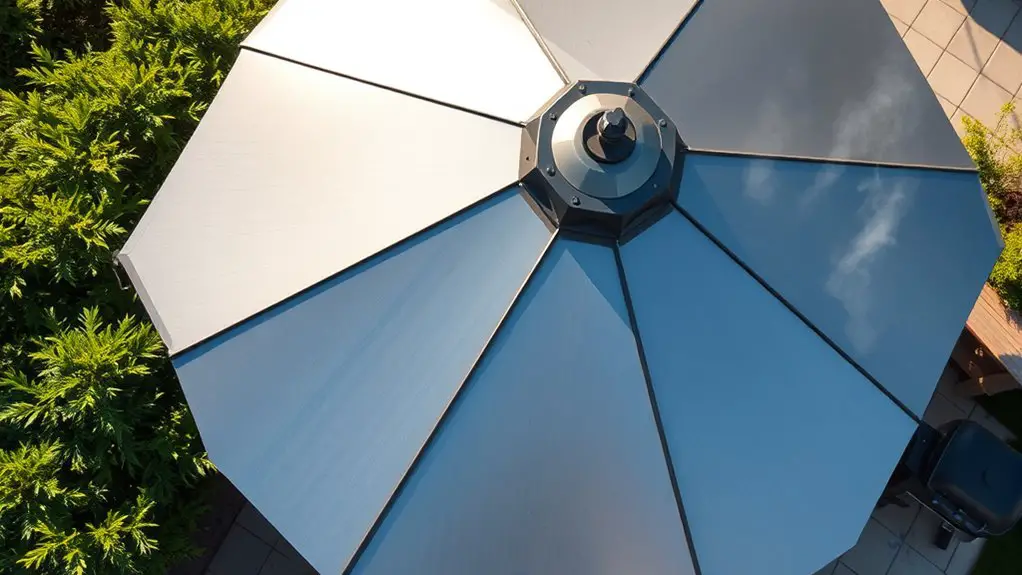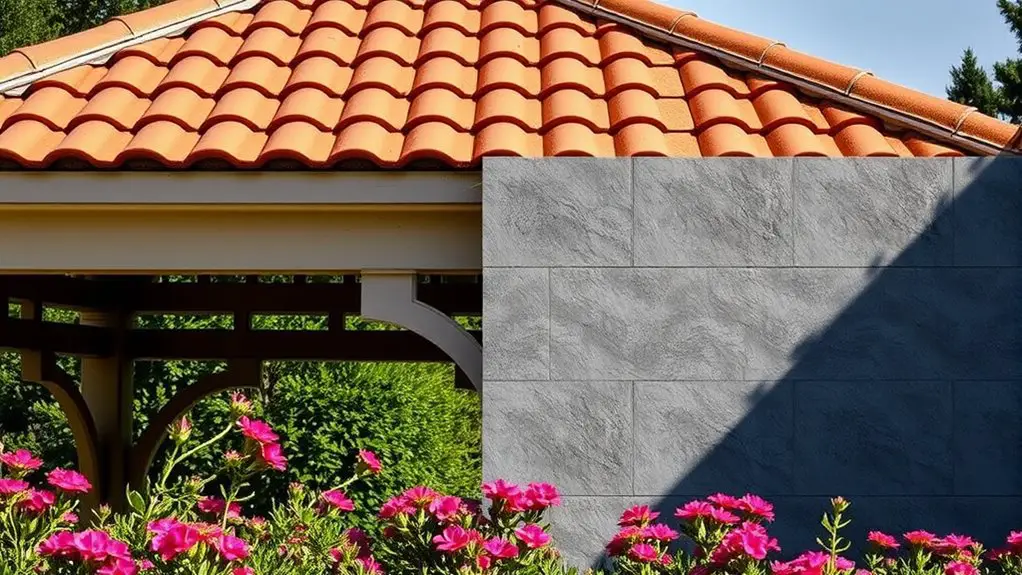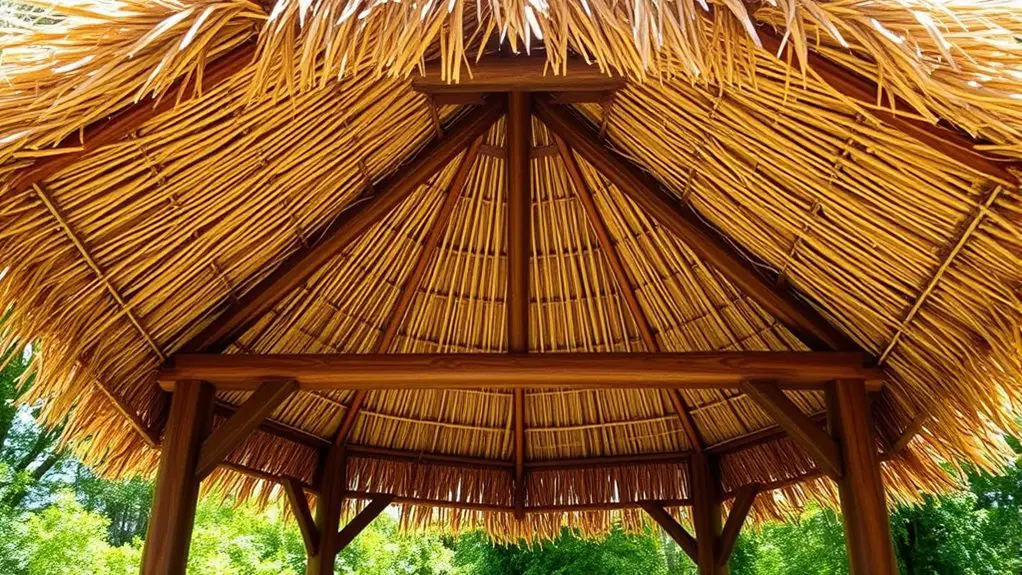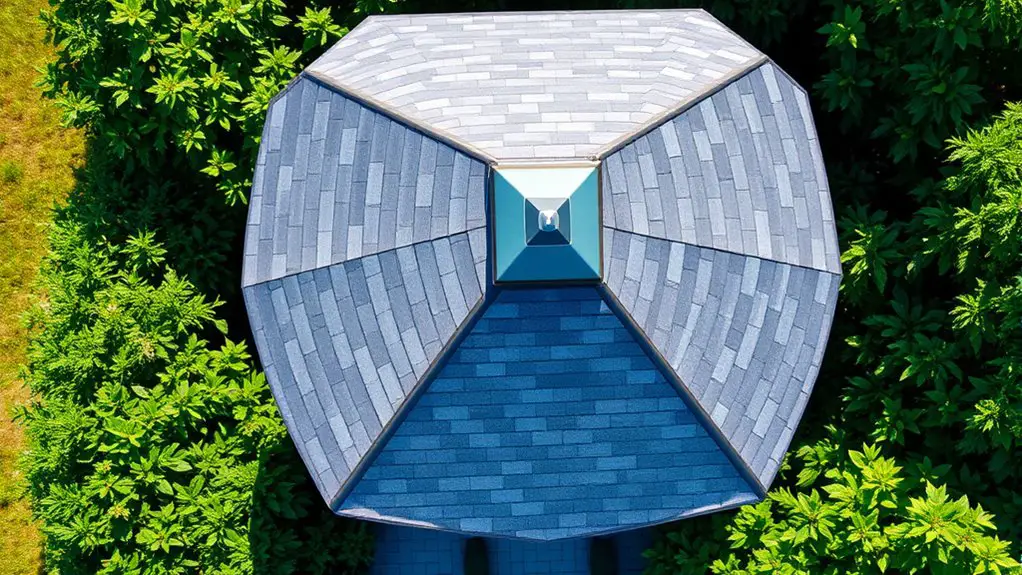For your gazebo, consider fire-resistant roofing materials like metal, slate, and fiberglass shingles. Metal roofing offers excellent durability and low maintenance, while slate provides aesthetic charm and exceptional fire resistance. Fiberglass shingles are lightweight and available in various styles. Clay tiles are also great due to their long-lasting durability. If you prefer a natural look, thatched roofing can be treated for fire resistance, though it requires regular upkeep. Explore more options to find the perfect fit.
Metal Roofing

Metal roofing stands out as one of the most reliable options for gazebos, especially in regions prone to wildfires. One of the key metal roofing benefits is its inherent fire resistance, which can greatly reduce the risk of ignition from embers or intense heat. You’ll also appreciate its durability, as metal roofs can withstand harsh weather conditions and last decades with minimal maintenance.
When considering metal roofing styles, you’ve got plenty of choices, including standing seam, corrugated, and metal shingles. Each style offers unique aesthetics, allowing you to customize your gazebo to match your home’s design. Additionally, metal roofs are energy efficient, reflecting solar heat and keeping your gazebo cooler in the summer. Their lightweight nature makes installation easier and less labor-intensive compared to traditional materials. Overall, metal roofing combines safety, longevity, and versatility, giving you peace of mind while enjoying your outdoor space.
Slate Roofing
While metal roofing provides excellent fire resistance, slate roofing is another top-tier option for gazebos, known for its remarkable durability and aesthetic appeal. One of the slate advantages is its natural resilience against extreme weather conditions, making it a long-lasting choice. Its non-combustible nature guarantees superior fire resistance, keeping your gazebo safe.
When considering slate installation, it’s vital to hire experienced professionals, as the material requires precise handling and specific techniques. The installation process involves using a solid underlayment and proper flashing to prevent water infiltration, guaranteeing longevity. Additionally, slate comes in various colors and textures, allowing you to tailor your gazebo’s appearance to fit your style.
With its unique blend of beauty and durability, slate roofing not only enhances your outdoor space but also protects it against fire hazards, giving you peace of mind while enjoying your gazebo.
Clay and Concrete Tiles

When it comes to fire-resistant roofing options for gazebos, clay and concrete tiles stand out as excellent choices. Both materials offer impressive fire resistance, making them ideal for outdoor structures. Clay tiles are renowned for their durability, able to withstand harsh weather conditions and resist cracking, fading, and mold growth. This longevity means you won’t need frequent replacements, enhancing the value of your investment.
On the other hand, concrete tiles provide remarkable aesthetics, mimicking the look of more expensive materials without the hefty price tag. You can choose from various colors and styles, allowing you to customize your gazebo’s appearance to match your personal style. Additionally, concrete’s weight contributes to its fire-resistant properties, offering peace of mind. By opting for clay or concrete tiles, you’re not just ensuring safety; you’re also enhancing your gazebo’s overall appeal and longevity. Furthermore, both materials contribute to long-term durability due to their resistance against weathering and other environmental factors.
Fiberglass Shingles
Fiberglass shingles are a popular choice for gazebo roofing due to their excellent fire resistance and versatility. One of the primary fiberglass advantages is their lightweight nature, making them easy to handle during fiberglass installation. They’re composed of a fiberglass mat coated with asphalt, which provides a robust barrier against flames and extreme weather conditions.
In addition to fire resistance, fiberglass shingles offer a broad range of colors and styles, allowing you to customize your gazebo to fit your aesthetic. Their durability means you’ll enjoy a long lifespan, often exceeding 30 years with proper care.
Installation is generally straightforward, often requiring less time and labor than heavier materials. Plus, their lower maintenance needs contribute to your overall freedom of enjoyment, minimizing upkeep. With fiberglass shingles, you can create a beautiful, functional, and safe outdoor space, ensuring your gazebo remains a cherished retreat for years to come.
Thatched Roofing

Thatched roofing, made from natural materials like straw or reed, offers a rustic aesthetic but comes with fire resistance limitations. While it can be treated with fire retardants, these treatments may not guarantee complete safety in high-risk areas. Additionally, regular maintenance is essential for longevity, as thatch can degrade quickly if not properly cared for.
Natural Materials Overview
Natural roofing materials, like thatch, offer a unique aesthetic appeal while also providing environmental benefits. Thatch, made from dried plant materials such as reeds or straw, serves as an effective natural insulation, keeping your gazebo cool in summer and warm in winter. This material not only enhances the beauty of your outdoor space but also boasts material sustainability, as it’s renewable and biodegradable. By choosing thatch, you’re supporting eco-friendly practices that minimize environmental impact. Additionally, its lightweight nature allows for easier installation and maintenance compared to heavier roofing materials. Embracing thatched roofing contributes to a harmonious blend of natural beauty and functionality, giving you the freedom to enjoy your gazebo in an environmentally conscious way.
Fire Resistance Limitations
While thatched roofing brings charm and sustainability to your gazebo, its fire resistance is a significant concern. Thatched materials, typically made from dried grass or reeds, generally fall short of modern fire resistance standards. When you compare them to alternatives like metal or tile, the differences are stark. Thatch’s organic nature makes it highly combustible, especially in dry conditions or with nearby heat sources. Many regions require specific fire resistance ratings for roofing materials, and thatched roofs often do not meet these regulations. If you prioritize safety and compliance, you may want to reconsider thatched roofing. Understanding material comparisons can help you make an informed choice that balances aesthetics with essential fire safety requirements.
Maintenance and Longevity
Maintaining thatched roofing requires diligent attention to detail and a thorough understanding of its unique properties. Regular roof inspections are essential to identify wear, mold, or pest infestations that can compromise your roof’s integrity. Make sure you check for loose or damaged thatch, as these can greatly impact longevity factors.
Cleaning the roof periodically will help remove debris and prevent moisture buildup, which can lead to decay. Additionally, consider applying a fire-retardant treatment to enhance its resistance to flames. Remember, the environment plays a role too; exposure to harsh weather can accelerate deterioration, so provide adequate shelter when possible. By staying proactive in maintenance, you’ll not only prolong the life of your thatched roofing but also enjoy its aesthetic charm longer.
Rubber Roofing
Rubber roofing offers a range of advantages for your gazebo, including excellent fire resistance and durability. When considering installation, it’s crucial to follow specific guidelines to guarantee a secure fit and longevity. Additionally, regular maintenance tips can help you maximize the lifespan of your rubber roofing, keeping it in prime condition for years to come.
Benefits of Rubber Roofing
When considering fire-resistant roofing materials for gazebos, rubber roofing stands out due to its impressive durability and resilience. Here are three key benefits that make it an excellent choice:
- Cost Effectiveness: Rubber roofing is often more affordable than traditional materials while providing long-lasting protection against the elements.
- Environmental Impact: Made from recycled materials, rubber roofing minimizes waste and promotes sustainability, making it an eco-friendly option for your gazebo.
- Fire Resistance: Its inherent properties make it resistant to fire, ensuring a safer environment for gatherings and relaxation.
Choosing rubber roofing not only enhances your gazebo’s longevity but also aligns with environmentally conscious values, allowing you to enjoy your space with peace of mind.
Installation and Maintenance Tips
Installing rubber roofing on your gazebo requires careful planning and execution to guarantee peak performance and longevity. Start by choosing the right thickness of rubber membrane, typically 45-60 mils for durability. Utilize proper installation techniques, such as overlapping seams and using adhesive specifically designed for rubber. Ascertain a smooth surface to prevent water pooling.
For maintenance, establish a regular maintenance schedule—inspecting the roof at least twice a year. Look for cracks, punctures, or loose seams, and address issues promptly to prevent leaks. Clean the roof regularly to remove debris and avoid mold growth. By adhering to these tips, you’ll enjoy a long-lasting, fire-resistant roofing solution that enhances your gazebo’s functionality and aesthetic appeal.
Treated Wood Shingles
Treated wood shingles offer a blend of aesthetic appeal and enhanced fire resistance, making them an excellent choice for gazebo roofing. These shingles are specially treated to withstand the elements while providing a charming, natural look. However, it’s essential to weigh the treated wood advantages and disadvantages before deciding.
Treated wood shingles beautifully combine aesthetic charm with enhanced fire resistance, making them an ideal roofing choice for your gazebo.
- Advantages:
- Improved fire resistance due to chemical treatments.
- Durable against pests and rot, extending lifespan.
- Eco-friendly options available if sourced responsibly.
- Disadvantages:
- Higher initial cost compared to traditional shingles.
- Requires regular maintenance to uphold fire resistance.
- Potentially harmful chemicals in some treatments.
Ultimately, if you’re after a roofing option that combines beauty with safety, treated wood shingles might just be the perfect fit for your gazebo, granting you the freedom to enjoy your outdoor space worry-free.
Frequently Asked Questions
How Do Fire-Resistant Roofs Affect Gazebo Insurance Premiums?
Fire-resistant roofs enhance fire safety, often leading to insurance discounts. Insurers recognize reduced risks, adjusting premiums accordingly. By investing in such materials, you can lower your overall insurance costs while ensuring your gazebo’s protection.
Are There Specific Fire Ratings for Each Roofing Material?
Yes, there are specific fire ratings for roofing materials, categorized into classifications like Class A, B, and C. These ratings indicate a material’s resistance to fire, helping you select the safest option for your needs.
Can Fire-Resistant Roofing Materials Withstand High Winds?
Imagine a stormy night, winds howling. Fire-resistant materials like metal roofs offer excellent wind resistance and material durability, ensuring your structure stands firm against harsh weather while providing peace of mind during unpredictable conditions.
How Often Should Fire-Resistant Roofing Be Inspected?
You should inspect fire-resistant roofing at least twice a year. Regular maintenance tips include checking for damage, ensuring proper drainage, and cleaning debris. This frequency helps maintain effectiveness and prolongs the lifespan of your roof.
Is Installation Different for Fire-Resistant Roofing Materials?
Yes, installation techniques for fire-resistant roofing materials can differ greatly. You’ll need to contemplate material compatibility with your existing structure, ensuring proper sealing and alignment to maximize effectiveness against fire hazards while maintaining structural integrity.

